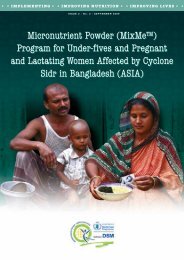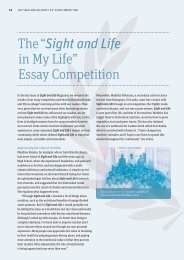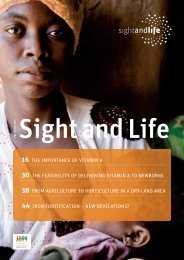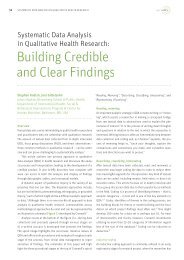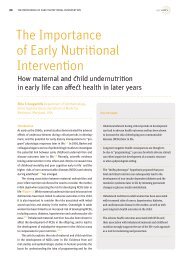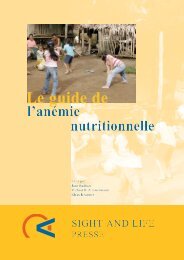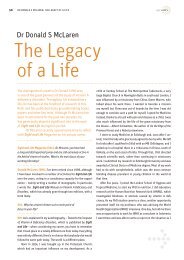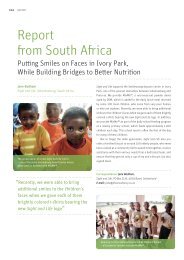16 intrauterine programming of ncd 24 olson memori... - DSM
16 intrauterine programming of ncd 24 olson memori... - DSM
16 intrauterine programming of ncd 24 olson memori... - DSM
- No tags were found...
Create successful ePaper yourself
Turn your PDF publications into a flip-book with our unique Google optimized e-Paper software.
SIGHT AND LIFE | VOL. 25 (2) | 2011 VITAMIN D AND INFLAMMATION 4343indicated a considerable inflammatory response. This inflammationwill have also increased the activity <strong>of</strong> macrophages in bodytissues and the uptake <strong>of</strong> 25(OH)D by stimulated macrophagescan be considerable. <strong>24</strong>“Innate immunity is the body’sfirst line <strong>of</strong> defenseagainst microbial attack”Innate immunity is the body’s first line <strong>of</strong> defense againstmicrobial attack. 25(OH)D taken up by stimulated macrophagesand epithelial cells is rapidly converted to 1,25(OH)₂D, whichinduces production <strong>of</strong> cathelicidin, a potent anti-microbial peptide.4 Innate immunity is also especially important in protectingthe gut, and vitamin D modulates anti-inflammatory Treg cellsand interleukin-10 production. 25 Experimental work has shownthat 1,25(OH)₂D inhibits the development <strong>of</strong> inflammatory boweldisease in IL-10, knock-out (KO) mice and that vitamin D-receptor-KOmice were hypersensitive to exogenous injections <strong>of</strong>bacterial lipo-polysaccharide (LPS), 26 while others have shownthat if such mice are infected with Salmonella there is greaterbacterial burden and mortality than in wild-type mice. 27 Furtherresearch is needed, however, to determine to what extent an upregulation<strong>of</strong> macrophage activity could explain the changes inplasma 25(OH)D concentrations.It was interesting that the reduction in free 25(OH)D concentrationsslightly increased plasma calcium during the postoperativeperiod, but did not disturb parathyroid hormone (PTH)concentrations. PTH would normally be sensitive to changes inplasma calcium, so the absence <strong>of</strong> any movement was a reflection<strong>of</strong> the minimal changes in calcium as a result <strong>of</strong> the inflammation.Alterations in fluid balance could also explain theconcentration changes in vitamin D, but the authors assured thereader that any fluids given were to maintain fluid balance andnot expand volumes. Furthermore, they were given over severalhours and therefore would have equilibrated with the entire extravascularfluid volume <strong>of</strong> ~14 L in an adult. This large volumewould not have significantly altered during the post-operativeperiod and would not, therefore, explain the 40% decrease in25(OH)D concentration.There was no association between plasma 25(OH)D and CRPconcentrations. 1 This is not surprising, since we have observedsimilar effects with other nutrients influenced by inflammation.No doubt there would be a close correlation between 25(OH)Dand CRP if multiple samples were taken over the first <strong>24</strong> hourspost-operatively. However, CRP concentrations will start to fallas soon as the clinical symptoms <strong>of</strong> the trauma recede. In contrast,25(OH)D concentrations and biomarkers such as retinol,ferritin and many other nutrients remain affected by the inflammationinto the convalescent period. 28 The rise in CRP, as withthe fall in 25(OH)D concentrations, is a product <strong>of</strong> the inflammatoryresponse but these probably have independent functions.That is, the changes are induced for different reasons as indicatedby CRP starting to fall on Day 4, while the concentration <strong>of</strong>25(OH)D remained unaltered.“Vitamin D is important for innateimmunity and rapid changes invitamin D metabolites in the plasmaare likely to be part <strong>of</strong> the innateimmune response”The potential benefit <strong>of</strong> large changes in 25(OH)DWhat the potential benefit <strong>of</strong> the large changes in 25(OH)D concentrationsbrought about by trauma is for the patient, is an interestingquestion. The data suggest that not only did total25(OH)D concentrations fall but there were also similar largereductions in the biologically active “free” 25(OH)D. It has to beremembered, however, that the concentration <strong>of</strong> 25(OH)D inplasma is 1,000-fold higher than 1,25(OH)₂D in plasma 9 and theauthors did not measure this important vitamin D metabolite inthe patients. Furthermore, a fall in the concentration <strong>of</strong> the VDBPmay have the effect <strong>of</strong> increasing the concentration <strong>of</strong> “free”table 4: Free (unbound) concentrations <strong>of</strong> 25-hydroxy-cholecalciferol (25(OH)D) in maternal and cord serumVitamin D binding-protein mg/L 25(OH)D μg/L Free 25(OH)D ng/LMothers n =30 574 14 0.34Infants n =30 268 8 0.44 #Data shown are means taken from Bouillon et al. 29# Free 25(OH)D concentrations were significantly higher in cord than maternal serum.



